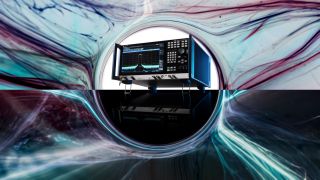Generating test signals with a vector signal generator
Using a vector signal generator is a more flexible and accurate way to create NPR test signals. With a vector signal generator, you can use a realistic test signal, i.e., a signal that is much closer to the ones normally used with the DUT. It’s also easier to create multiple notches, and you can typically get better notch quality, i.e., steep, deep and narrow.
There are several ways to create notches in the vector signal domain:
- Offline processing: The notch is statically added to an arbitrary waveform file using a tool like MATLAB.
- Multi-carrier continuous wave (CW): Large numbers of unmodulated carriers are used to “fill up” the test signal bandwidth, minus the notches.
- Digital notch filter: Digital notch filters are used to create notches in any type of signal.
Using digital notch filters is the preferred method for creating NPR test signals. They offer the highest level of realism because they can be used with the actual modulated signal types carried by the system. They are also completely flexible, so you can create multiple notches of arbitrary width and position. And finally, they can be defined, updated and enabled or disabled in real-time, with no need for offline pre-calculation of waveforms.















